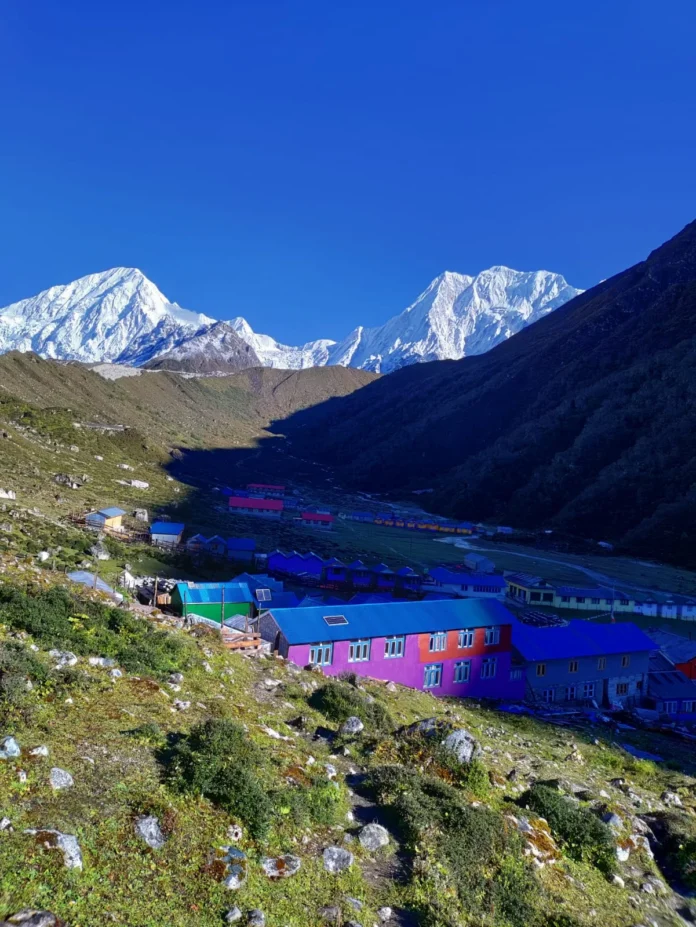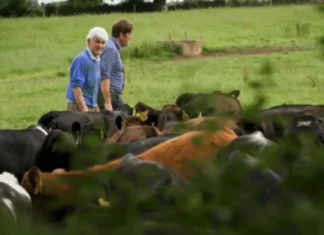The Manaslu Circuit Trek is one of Nepal’s most rewarding long-distance treks, combining snow-clad Himalayan peaks, deep valleys, and remote Tibetan-influenced villages. Centered around Mount Manaslu (8,163m), the world’s eighth-highest mountain, this trail leads through landscapes that feel both raw and unspoiled. Unlike the busier Everest and Annapurna routes, Manaslu remains quieter, with fewer trekkers and a sense of genuine wilderness.
This trek appeals to those seeking adventure with cultural depth. You’ll walk through Buddhist monasteries, mani walls, and timeless villages like Samagaun and Lho, where life still follows traditional rhythms. At the same time, the trail builds toward one of Nepal’s great challenges: crossing the Larke La Pass at 5,106m, a high, windswept pass with wide views of the Himalayas.
For experienced trekkers, the Manaslu Circuit is a natural choice. But it’s also open to adventurous first-timers ready to commit to a longer hike with daily ascents and descents. Whether you’re after a cultural trek in a restricted region or a strenuous adventure across varied terrain, Manaslu gives you both.
Trek Overview
- Location: Gorkha District, Nepal (Manaslu Conservation Area).
- Duration: 14–18 days, ~177 km total, 6–7 hours average walking per day.
- Difficulty: Strenuous.
- Highest altitude: Larke La Pass (5,106m).
- Accommodation: Tea houses along the route.
- Best time to go:
- Spring (March–May): Clear skies, rhododendrons in bloom.
- Autumn (Sept–Nov): Stable weather, excellent mountain visibility.
- Spring (March–May): Clear skies, rhododendrons in bloom.
- Highlights:
- Crossing the Larke La Pass.
- Close-up views of Mount Manaslu.
- Remote Tibetan-style villages and monasteries.
- Less crowded than Everest or Annapurna.
- Crossing the Larke La Pass.
Day-by-Day Itinerary
- Day 1: Drive Kathmandu → Soti Khola (700m). Long jeep ride, overnight in Soti Khola.
- Day 2: Trek Soti Khola → Machha Khola (930m), ~6 hrs. Forests, suspension bridges.
- Day 3: Machha Khola → Jagat (1,410m), ~7 hrs. River gorges, stone-paved village.
- Day 4: Jagat → Deng (1,804m), ~7 hrs. Entry into a restricted zone.
- Day 5: Deng → Namrung (2,630m), ~6 hrs. First glimpses of Manaslu peaks.
- Day 6: Namrung → Lho (3,180m), ~5 hrs. Mani walls, monasteries, and clear mountain views.
- Day 7: Lho → Samagaun (3,530m), ~5 hrs. Trail through alpine fields, views of Manaslu.
- Day 8: Acclimatization in Samagaun. Side trips to Manaslu Base Camp or Pungyen Monastery.
- Day 9: Samagaun → Samdo (3,860m), ~4 hrs. Remote village near the Tibetan border.
- Day 10: Samdo → Dharamsala (4,460m), ~4 hrs. Short but steep climb to high camp.
- Day 11: Dharamsala → Larke La Pass (5,106m) → Bimthang (3,590m), 8–9 hrs. The toughest and most rewarding day.
- Day 12: Bimthang → Tilije (2,300m), ~6 hrs. Descend through rhododendron and pine forests.
- Day 13: Tilije → Dharapani (1,970m), ~5 hrs. Join Annapurna Circuit trail.
- Day 14: Drive Dharapani → Kathmandu.
Highlights of the Trek
The landscapes on the Manaslu circuit trek are as varied as they are dramatic. You’ll pass through subtropical forests and rice terraces before climbing into alpine meadows and glacier-carved valleys. Higher up, the views open to towering peaks including Manaslu, Himlung, Cheo Himal, and Annapurna II. Crossing the Larke La Pass provides a sweeping panorama across both Manaslu and the Annapurna ranges.
The trek is also a cultural journey. Many villages, like Lho and Samagaun, have Tibetan-style monasteries where prayer flags ripple in the wind. You’ll walk past mani walls carved with Buddhist scriptures, and in places like Samdo you’ll meet communities with deep ties to Tibet. During festival periods, traditional dances and rituals add to the experience.
Nature thrives here too. In spring, rhododendrons light up the forests, while higher altitudes bring encounters with grazing yaks and herds of blue sheep. Birdlife is abundant, with Himalayan griffons circling overhead.
Suspension bridges over the Budhi Gandaki River, ancient trails cut into cliffs, and quiet valleys untouched by mass tourism make the Manaslu Circuit distinct. It feels wild and isolated, yet every village welcomes you with the warmth of tea houses and wood-fired stoves.
Practical Informations
Permits
The Manaslu Circuit requires multiple permits:
- Manaslu Restricted Area Permit (RAP): $100 per person for the first week, $15 per additional day.
- Annapurna Conservation Area Permit (ACAP): $30 per person.
- Manaslu Conservation Area Permit (MCAP): $30 per person.
Permits are issued in Kathmandu through registered trekking agencies. Solo trekking is not allowed; you must trek with a registered guide.
Accommodation
Along the Manaslu Circuit, trekkers stay in local tea houses, which are family-run lodges built to serve hikers. These lodges typically have wooden rooms with two single beds, thin mattresses, and blankets. Heating is rarely available in bedrooms, so bringing a warm sleeping bag is strongly advised, especially above 3,000m. Toilets are usually shared, with squat-style toilets being common in smaller villages, though some places in Namrung and Samagaun now have attached bathrooms. Showers range from cold bucket washes to paid hot showers, often heated by solar or gas. Compared to the Everest or Annapurna regions, facilities here are simpler, but that’s part of the circuit’s charm — it feels more remote and less commercialized.
Food
Meals are prepared in the tea houses and revolve around local ingredients. The staple is dal bhat (rice, lentil soup, vegetables, and sometimes pickles), which is both filling and refillable. Other common meals include noodle soup, Tibetan bread with jam or honey, fried rice, pancakes, and simple pasta. Breakfast often consists of porridge, muesli, or eggs. At higher altitudes, food options become more limited, and costs increase because everything has to be carried up by mules or porters. Expect to pay double the Kathmandu price for items like tea, chocolate, or soft drinks. Snacks such as Snickers, biscuits, and instant noodles are available in some villages, though it’s smart to carry a small supply of your own favorites from Kathmandu.
Guides & Porters
Because the Manaslu Circuit falls inside a restricted trekking zone, trekking with a licensed guide is mandatory. Guides do more than navigate — they handle permits, organize accommodation, and provide insight into the culture and mountains. A good guide can also help in emergencies such as altitude sickness or injuries. Daily rates are around $30–40. Porters are optional but highly recommended if you prefer to trek light; they usually carry 20–25 kg for $20–25 per day. It’s respectful to keep loads reasonable and to provide them with proper gear. Hiring local staff not only eases your trek but also directly benefits the mountain communities.
Transport
Reaching the start of the Manaslu Circuit involves a long and sometimes bumpy jeep ride from Kathmandu to Soti Khola. Depending on road and weather conditions, the trip can take 8–10 hours. Some trekkers break the journey with an overnight stop in Arughat, but most continue directly. At the end of the trek, you’ll exit at Dharapani, where the trail meets the Annapurna Circuit. From there, jeeps or local buses run back to Kathmandu. Travel times are unpredictable due to landslides, muddy tracks, or traffic, so it’s wise to keep at least a day or two buffer in your schedule.
Budget & Costs
A Magical Nepal group trek for the Manaslu Circuit generally starts at around $1,100–1,300 per person, depending on group size. Private treks cost more, usually $1,400–1,700, but allow flexibility with pace and itinerary. These packages cover permits, guides, porters, accommodation, and meals on the trail.
Extra expenses should be considered. WiFi access, where available, costs $2–5 per login. Charging electronics is often charged separately ($1–3 per hour). Hot showers in tea houses may cost $2–5. Snacks, bottled water, and drinks can add significantly to the daily spend, especially at higher altitudes.
Tipping is customary: about 10% of the trek cost is shared among guides and porters.
Overall, budgeting around $1,500–2,000 ensures a comfortable trek, inclusive of hidden costs and personal expenses.
Packing & Preparation Tips
Good preparation makes the Manaslu trek more enjoyable. Sturdy trekking boots are essential for long days on rocky trails. Layered clothing is important: lightweight shirts for lower sections, warm fleece or down jackets for higher altitudes, and waterproof gear for unpredictable mountain weather.
Other essentials include trekking poles, a headlamp, a water filter or purification tablets, and a sleeping bag rated to -10°C. Crampons or microspikes are recommended in spring or late autumn for crossing the Larke La, when snow or ice can linger.
Acclimatization is crucial. Walk slowly, hydrate, and consider carrying medication like Diamox. Fitness preparation should include cardio and leg strength training, as daily treks involve steep ascents and descents.
Conclusion
The Manaslu Circuit is a trek that combines remoteness, cultural immersion, and high Himalayan adventure. From stone-built villages to the sweeping heights of Larke La, the journey is physically demanding but deeply rewarding. It’s less crowded than the Everest or Annapurna regions, giving trekkers a rare sense of space and authenticity.
If you’re ready for a longer, more challenging trek in Nepal, this is an experience worth considering. With the right preparation and the support of experienced guides, you’ll find the Manaslu Circuit to be a true mountain adventure.













